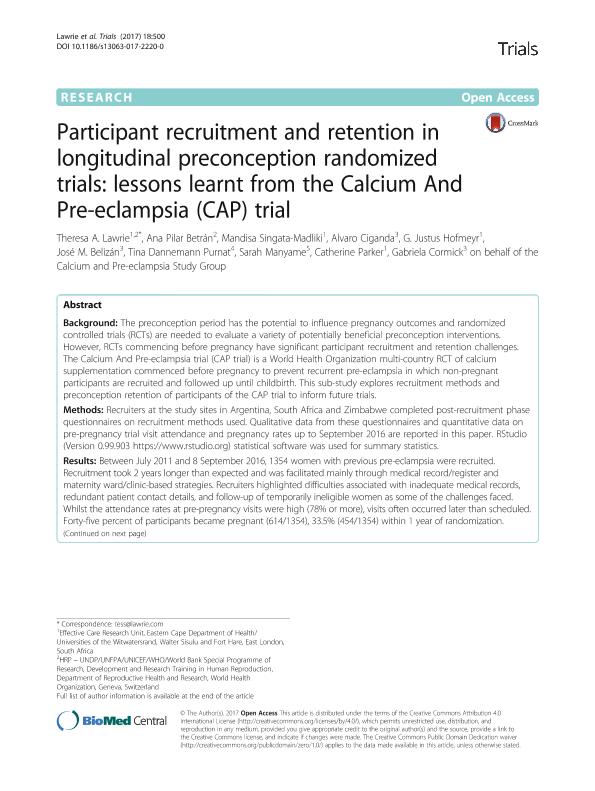Mostrar el registro sencillo del ítem
dc.contributor.author
Lawrie, Theresa A.
dc.contributor.author
Betrán, Ana Pilar
dc.contributor.author
Singata Madliki, Mandisa
dc.contributor.author
Ciganda, Alvaro
dc.contributor.author
Hofmeyr, G.Justus
dc.contributor.author
Belizan, Jose

dc.contributor.author
Purnat, Tina Dannemann
dc.contributor.author
Manyame, Sarah
dc.contributor.author
Parker, Catherine
dc.contributor.author
Cormick, Gabriela

dc.date.available
2018-04-03T18:14:29Z
dc.date.issued
2017-10
dc.identifier.citation
Lawrie, Theresa A.; Betrán, Ana Pilar; Singata Madliki, Mandisa; Ciganda, Alvaro; Hofmeyr, G.Justus; et al.; Participant recruitment and retention in longitudinal preconception randomized trials: Lessons learnt from the Calcium And Pre-eclampsia (CAP) trial; BioMed Central; Trials; 18; 1; 10-2017
dc.identifier.issn
1745-6215
dc.identifier.uri
http://hdl.handle.net/11336/40518
dc.description.abstract
Background: The preconception period has the potential to influence pregnancy outcomes and randomized controlled trials (RCTs) are needed to evaluate a variety of potentially beneficial preconception interventions. However, RCTs commencing before pregnancy have significant participant recruitment and retention challenges. The Calcium And Pre-eclampsia trial (CAP trial) is a World Health Organization multi-country RCT of calcium supplementation commenced before pregnancy to prevent recurrent pre-eclampsia in which non-pregnant participants are recruited and followed up until childbirth. This sub-study explores recruitment methods and preconception retention of participants of the CAP trial to inform future trials. Methods: Recruiters at the study sites in Argentina, South Africa and Zimbabwe completed post-recruitment phase questionnaires on recruitment methods used. Qualitative data from these questionnaires and quantitative data on pre-pregnancy trial visit attendance and pregnancy rates up to September 2016 are reported in this paper. RStudio (Version 0.99.903 https://www.rstudio.org ) statistical software was used for summary statistics. Results: Between July 2011 and 8 September 2016, 1354 women with previous pre-eclampsia were recruited. Recruitment took 2 years longer than expected and was facilitated mainly through medical record/register and maternity ward/clinic-based strategies. Recruiters highlighted difficulties associated with inadequate medical records, redundant patient contact details, and follow-up of temporarily ineligible women as some of the challenges faced. Whilst the attendance rates at pre-pregnancy visits were high (78% or more), visits often occurred later than scheduled. Forty-five percent of participants became pregnant (614/1354), 33.5% (454/1354) within 1 year of randomization. Conclusions: In preconception trials, both retrospective and prospective methods are useful for recruiting eligible women with certain conditions. However, these are time-consuming in low-resource settings with suboptimal medical records and other challenges. Trial planners should ensure that trial budgets cover sufficient on-site researchers with pre-trial training, and should consider using mobile phone and web-based electronic tools to optimize recruitment and retention. This should lead to greater efficiency and shorter trial durations. Trial registration: Pan-African Clinical Trials Registry, Registration Number: PACTR201105000267371. The trial was registered on 6 December 2016.
dc.format
application/pdf
dc.language.iso
eng
dc.publisher
BioMed Central

dc.rights
info:eu-repo/semantics/openAccess
dc.rights.uri
https://creativecommons.org/licenses/by-nc-sa/2.5/ar/
dc.subject
Calcium
dc.subject
Pre-Eclampsia
dc.subject
Preconception
dc.subject
Randomized
dc.subject
Recruitment
dc.subject
Retention
dc.subject.classification
Salud Ocupacional

dc.subject.classification
Ciencias de la Salud

dc.subject.classification
CIENCIAS MÉDICAS Y DE LA SALUD

dc.title
Participant recruitment and retention in longitudinal preconception randomized trials: Lessons learnt from the Calcium And Pre-eclampsia (CAP) trial
dc.type
info:eu-repo/semantics/article
dc.type
info:ar-repo/semantics/artículo
dc.type
info:eu-repo/semantics/publishedVersion
dc.date.updated
2018-03-27T19:59:29Z
dc.journal.volume
18
dc.journal.number
1
dc.journal.pais
Reino Unido

dc.journal.ciudad
Londres
dc.description.fil
Fil: Lawrie, Theresa A.. Universities of the Witwatersrand; Sudáfrica. World Health Organization; Suiza
dc.description.fil
Fil: Betrán, Ana Pilar. World Health Organization; Suiza
dc.description.fil
Fil: Singata Madliki, Mandisa. Universities of the Witwatersrand; Sudáfrica
dc.description.fil
Fil: Ciganda, Alvaro. Instituto de Efectividad Clínica y Sanitaria; Argentina
dc.description.fil
Fil: Hofmeyr, G.Justus. Universities of the Witwatersrand; Sudáfrica
dc.description.fil
Fil: Belizan, Jose. Instituto de Efectividad Clínica y Sanitaria; Argentina
dc.description.fil
Fil: Purnat, Tina Dannemann. World Health Organization Regional Office for Europe; Dinamarca
dc.description.fil
Fil: Manyame, Sarah. University of Zimbabwe; Zimbabue
dc.description.fil
Fil: Parker, Catherine. Universities of the Witwatersrand; Sudáfrica
dc.description.fil
Fil: Cormick, Gabriela. Instituto de Efectividad Clínica y Sanitaria; Argentina
dc.journal.title
Trials

dc.relation.alternativeid
info:eu-repo/semantics/altIdentifier/doi/http://dx.doi.org/10.1186/s13063-017-2220-0
dc.relation.alternativeid
info:eu-repo/semantics/altIdentifier/url/https://trialsjournal.biomedcentral.com/articles/10.1186/s13063-017-2220-0
Archivos asociados
